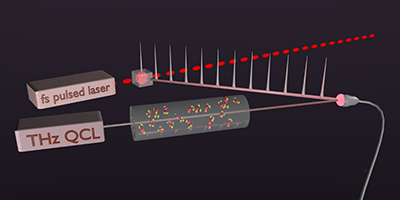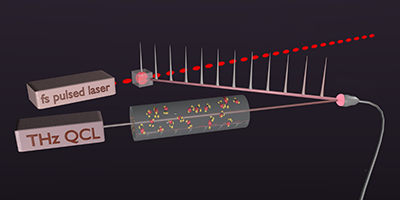High-Precision Terahertz Spectroscopy
Trace-gas sensing with high sensitivity and precision in the terahertz regime can be important in environmental monitoring, security, and astrophysics, as well as in tests of fundamental physics. Now, as reported in Physical Review X, a research team has performed the first terahertz spectroscopic measurements using a so-called frequency comb—a technique that allows frequency measurements with extremely high accuracy. As a proof-of-principle, the team measured a rotational transition in a gas molecule (methanol) to a precision of parts in one billion, times better than the previous record. The result is also twice as precise as the theoretically predicted frequency, suggesting the technique could help refine theoretical models.
Saverio Bartalini of the Italian National Institute of Optics (INO-CNR) and the European Laboratory for Non-linear Spectroscopy (LENS) and his colleagues have taken a terahertz system they previously developed and used it for spectroscopy. The researchers focused near-infrared laser pulses into a nonlinear crystal to produce a terahertz comb—a single beam containing thousands of discrete and closely spaced frequencies of light. The comb is referenced to a cesium atomic clock. To provide enough intensity for spectroscopy, they “phase locked” a quantum cascade laser to one of the comb’s “teeth.” The result is an ultrastable source with which they can measure the absorption of a gas sample as they slowly vary the laser frequency. With some simple improvements, the authors believe they can further boost their measurement precision by a factor of – David Ehrenstein





